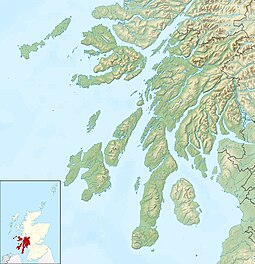Fraoch Eilean, Loch Awe
| Gaelic name | Fraoch Eilean |
|---|---|
| Meaning of name | Heather Island |
| Location | |
|
Fraoch Eilean shown within Argyll and Bute
|
|
| OS grid reference | NN108251 |
| Coordinates | 56°22′49″N 5°03′57″W / 56.380209°N 5.065834°W |
| Physical geography | |
| Island group | Loch Awe |
| Administration | |
| Sovereign state | United Kingdom |
| Country | Scotland |
| Council area | Argyll and Bute |
| References | |
Fraoch Eilean is a small island situated at the northern end of Loch Awe, a freshwater lake in Argyll and Bute, Scotland. It is notable for being the site of a medieval royal castle, now ruined, which was given into the keeping of Clan Macnaghten by Alexander III in 1267.
The name Fraoch Eilean means literally "heather island" in Scottish Gaelic, although Lord Archibald Campbell believes that the ordering of the words give the meaning more correctly as the "Isle of Fraoch".Fraoch was a hero of Celtic mythology. Fruit that restored youth and cured hunger was said to hang from a Rowan tree growing on an island in Loch Awe. The tree was guarded by a serpent or dragon which was wrapped around the trunk. Fraoch succeeded in stealing fruit from the tree, but when he was sent back to get the tree itself, the dragon pursued him. In the ensuing battle, both Fraoch and the dragon died. A cairn was raised on the spot where Fraoch fell and the island named in his honour. This legend, a version of the Hesperides myth, is recounted in a Gaelic ballad, Bás Fraoich, which was collected by Jerome Stone, the schoolmaster at Dunkeld, and published in his metrical English translation in The Scots Magazine, January 1756.
Fraoch Eilean is one of a group of small islands at the north end of Loch Awe. To the north of Fraoch Eilean lies Innischonain and to the south is Inishail. Eilean Beith and Badan Tomain are smaller islets to the north east. Further to the north east beyond the headland of Rubha Duibhairt there is a crannóg or artificial island with a second to the east near the shores of Loch Awe.
The island of Fraoch Eilean itself consists of two rocky eminences connected by a sand and shingle beach. The ruins of a castle occupy much of the eastern eminence. Vitrified stone has been found on the island close to the ruins of the castle.
...
Wikipedia

